17 Plants for Bees in the Garden
August 4th, 2022 | Categories
Wildlife in the garden is a lovely, enjoyable, and welcome sight. Seeing lots of animals and insects is certainly something that evokes the feeling of summer in our gardens. Especially our bees, as they buzz from flower to flower, pollinating as they go about their work. Our gardens are extremely important territory for bees, providing them with a source of nectar and pollen to help them thrive. Bees are also very important to us too of course. They contribute immensely to the health of our plants, flowers, and crops, and to the wider biodiversity of our environment.
If you’d like to attract more bees to your garden, then planting specifically for them is a great way to do it. If you can attract more bees, you’ll generally attract more pollinators too, so you’ll be helping a variety of important species while enjoying them as they go about their business in the garden. Our bees, like many pollinators, are in a bit of a decline because of habitat loss due to urbanisation for example. But our gardens can be a place where we can give them all the nectar and pollen they need to thrive. You might think, what can I do with just one garden? Well, did you know our gardens cover nearly half a million hectares of land in Britain? This an area greater than all our nature reserves combined!
By growing a mixture of flowering plants in our gardens – pots and containers work just as well too – we can provide a wealth of nectar and pollen for all our native bees pollinators. They’ll really appreciate it and will in turn keep your garden lush and healthy, not to mention keep our environment and economy healthy too.
Why are Bees Important?
Bees are the heavyweights of pollination. More than 90% of the leading global crop types are visited by bees. They are extremely important to our eco-system because they are vital to having a healthy environment and healthy economy. If we don’t protect bees, it will have serious implications for our biodiversity, our crops and food production, and even decorative ornamental plants that we love will disappear. Most plants we need for food rely on pollination. With bees being such prolific pollinators, without them we wouldn’t have any food on our plates, nor would we have wild plants that support so much other wildlife.
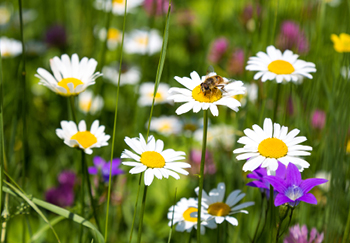
How do they do it? Well, as the bees go on to travel from flower to flower, they also pollinate them. This happens when the bees land on the flowers. Pollen from the male reproductive organ of the flower sticks to the hairs of the bee’s bodies. When the bees visit the next flower, some of this pollen is rubs off onto the female reproductive organ of the flower. The whole process of transferring pollen enables plant and flowers and trees to produce seeds or fruit.

Bees also pollinate about 80% of all wildflowers in Europe, so imagine if that were to drop significantly; our countryside would be a far less interesting and beautiful place. That would be a real shame. We’d also have no honey or honey products – imagine that!
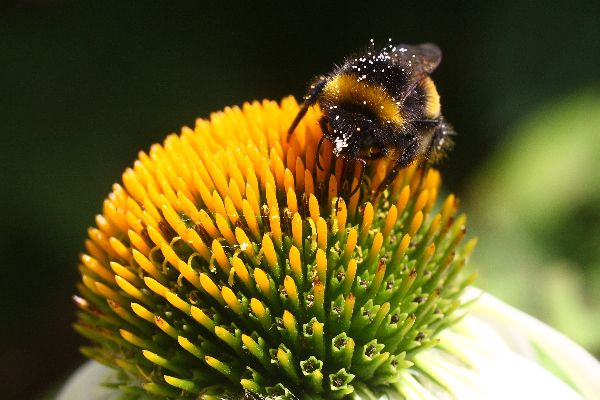
What Bees Do We Have in the UK?
‘Bees’ collectively refer to Bumblebees, Honeybees, and Solitary Bees. There are many species of bee in Britain and over 20,000 known species of bee in the world.
Bumblebees
Arguably the most recognisable bee around with their black and yellow stripy bands around their furry bodies. They use a method called “buzz pollination” where it places its upper body close to flower and vibrates its flight muscles. This vibration shakes the pollen from the flower. The pollen sticks to its furry body and the bumblebee then pollinates the next flower it lands on by doing this buzz, simultaneously gathering more pollen. Bumblebees are much more efficient pollinators than honeybees. We have 25 bumblebee species in the UK.
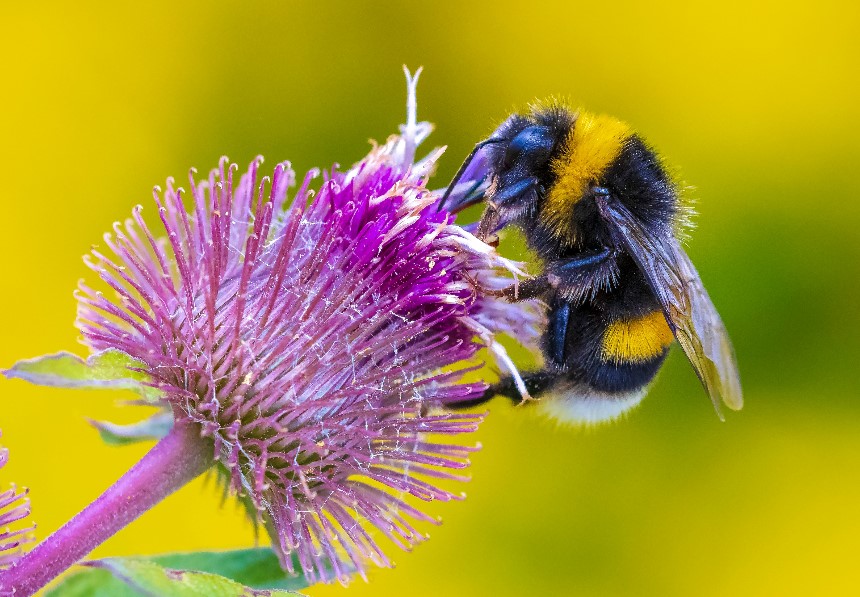
Honeybees
Most Honeybees are kept by beekeepers in colonies of managed hives. It has been like this for centuries and it is rare to find a truly wild colony. They are recognisable by their slimmer bodes compared to bumblebees and have brownish-ginger colour bands striped around their bodies. Honeybees pollinate plants as they forage on the flowers looking for nectar and pollen. As they continue gathering pollen and nectar, they transfer pollen from one flower to another. Only honeybees specifically produce honey, as honey is their main food. We only have one species of honeybee in the UK.

Solitary Bees
When most people think about bees, they think about honeybees and bumblebees. But over 90% of bees in the UK are solitary bees. Solitary bees tend to nest on their own, as the name suggests. Each female builds and provisions her own nest with food. Solitary bees include Mining bees which nest in the ground, as well as Mason bees and Leafcutter bees that nest in holes in dead wood, banks and walls. They are not as recognisable generally as bumble or honeybees. Solitary bees are not a lesser pollinator as you may think not being in a colony. A single Red Mason bee for instance is thought to pollinate the equivalent of 120 honeybees. They are also non-aggressive and do not swarm.
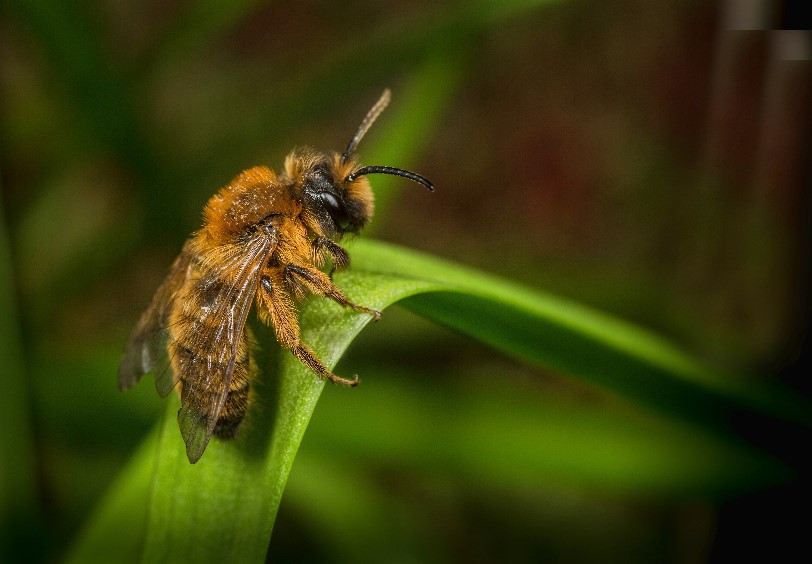
Plants that Help Bees
Now that you know a bit more about our bees here are 17 plants that help them providing them with a good source of nectar and pollen for years to come.
Lavender
Bees can see the colour purple more clearly than any other. That makes lavender and lots of other purple flowers especially good. Lavender has both pollen and nectar they can feed on in a single plant, usually in plentiful amounts. It’s one of the most versatile plants around and will do well in the ground, in pots, flowerbeds and nearly anywhere you’d want to include it. Lavender, with its strong scent, is known to repel pests in the garden.
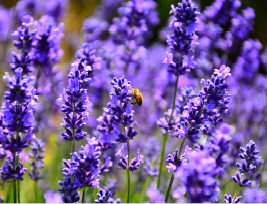
Catmint
Catmint is another great choice for bees, and in particular it’s a bumblebee’s favourite. It produces lots of pollen and nectar generally. The long-lasting flowery spikes mean that bees will return to it again and again through the season. Like Lavender, Catmint has the added benefit of being able to deter pests like aphids from the garden.
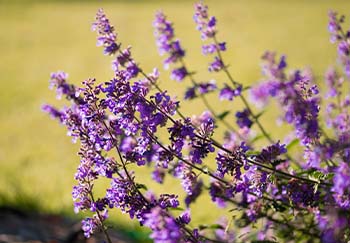
Alliums
Similarly, to Catmint and Lavender, Alliums are a favourite of all bees and pollinators. Their purple flowerheads offer a bounty of pollen and nectar for bees. The dense flowerheads have the added benefit of not making bees fly from flower to flower, thereby saving them energy.

Foxgloves
Foxgloves are great for bees, especially bumblebees, which they have evolved to attract. The tubular flowers make it simple for bees to land on to gather nectar and the plant itself provides lots of flowers over its long stems. They’re also lovely to see blooming in the garden.
Verbena
Verbenas are great for bees because of their nectar and pollen rich flowers. They also look great and come in a variety of vibrant colours like reds, pinks, blues, and purples. Plant them tightly in your flower beds for a remarkable long-lasting floral display and food source for the bees.

Honeysuckle
Honeysuckle is a climbing plant with lovely pink scented flowers that bees love. It does it all for wildlife and pollinators. It has plenty of nectar for insects, in turn attracting prey for bats, when mature offers nesting sites for birds, and berries for birds and small mammals.

Dahlia
Dahlias are great because they offer us wonderful blooms of lovely colourful flowers, and they offer bees lots of nectar and pollen. Win win. They come in a variety of types and double-flowered and single-flowered forms. The single-flowered types are more accessible to bees, however. They are particularly good for providing a late source of nectar in the year.

Antirrhinum (Snapdragons)
Snapdragons have unique looking flowers in terms of colour and shape, even the scent is known to be unique. They are great cottage garden plants that are brilliant for bees due to their long flowering period. It is a very versatile plant too, coming in a variety of colours and heights which means it can be used in a variety of planting situations in the garden.
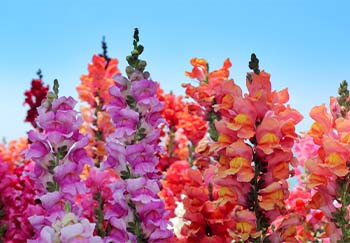
Dianthus
The bright colours of the dianthus flower attract bees to their bounty of nectar and pollen. Dianthuses are wonderfully flagrant and great for beds and borders. They will do well in pots and containers but are also great for hanging baskets, window boxes and rockeries too. The bees will love them!

Pulmonaria
Pulmonaria are semi-evergreen plants with lovely, dainty, little flowers that are an excellent early source of nectar for bees. The flowers are a lovely pinkish blue and will help to add interest to your garden too. They don’t like full sun though – this will make them wilt and look poorly – so best placed in shadier areas.

Anemones
Anemones are another brilliant choice for bees. The open flower creates an easy landing pad for them to get on and gather pollen and nectar. The plants are a great addition for them as they provide lots of pollen and are a lovely and colourful addition to any garden.

Azaleas
Azaleas offer up large amounts of sugar-rich nectar to bees, so they absolutely love them. They are a hardy shrub too, providing year-round interest for the garden with their vibrant flowers that come in a range of colours. Azaleas do equally well in the ground and in containers.
Fuchsia
With a lot of nectar, bees are always very attracted to Fuchsias. They also bloom abundantly, and their lovely unique teardrop shaped flowers add wonderful interest to any garden.

Lupins
Lupins don’t have much in the way of nectar but do have lots of pollen for bees. It is a bright, colourful flower that the bees love with bonus of interest for you with its unique spikes of flowers in a variety of colours. Lupins will do equally well in the ground or a nice large container.
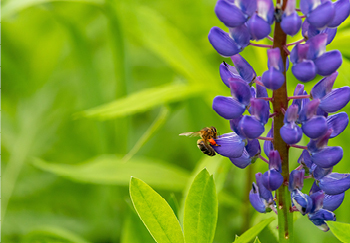
Heather
Flowering heathers are not only wonderful to look at, but they are also a wonderful source of winter food for any bees which are still active. It has been discovered that heathers may even act as a medicinal plant for bees helping them to fend off parasites. Heathers generally, are under threat, with many heathlands across Britain now gone due to agriculture. So, planting some heathers will not only help the pollinators, but the heather itself. Plus, they look amazing in winter when there is less colour in the garden.

Primrose
Primroses are an excellent source of nectar for all pollinators especially bees with longer mouth parts. Primroses have great variation of colours from deep yellow to almost white or even pink so you can brighten up the garden easily with these lovely little flowers. Plant them under shrubs or trees for a woodland effect. They’ll also do well in containers.
Geranium
Geraniums produce nectar and pollen, and most varieties are popular with bees. Geraniums are great because they are hardy, low-maintenance, and great for planting in gaps in borders.

Other Ways to Help Bees
In addition to the plants above, there are some other ways we can help pollinators too.
Let the Grass Grow Wild
Allow a bit off your lawn and lawn weeds to flower by cutting less often. You don’t have to do this in the entire garden, perhaps just a few square metres if you have the space. Leaving patches of grass to grow wild will let wildflowers grow and in turn these make great spots for bees to gather more nectar and pollen.

Water Sources
Bees need sources of water for drinking and reproduction. It’s not uncommon for the poor things to get too hot and burn out. Nor is it uncommon for them to drown in deep water sources. Think shallow and broad sources rather than deep. Adding sources of water is as easy as adding a bird bath or a puddling area. You can also provide water by hanging a dripping bottle or placing a small container of water out in the open.
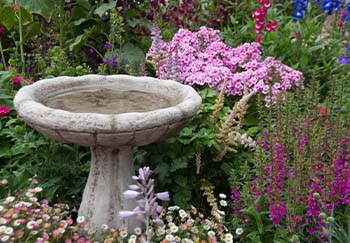
Companion planting
A great method to help control pests is companion planting, for instance nasturtium attracts aphids from other plants. Many types of herbs are also good companion plants, as their strong scents act as a deterrent to pests. Lavender itself is also believed to be a deterrent of certain pests due to its strong scent. So, if you prefer the organic control method really consider companion planting. If you, like the bees, prefer the organic control method, you should really consider companion planting.
Provide Shelter
Bees love dry, dark cavities, and long grassy patches, exposed soil, hedges, trees, dead hollow wood, and bark, to highlight some places where they would take shelter. Solitary bees will create their own nests, but bumblebees will nest socially in a hive, typically underground, under sheds, and even in compost heap (though not limited to these places). You can really help by developing one or two of these areas in your garden, like a corner with lots of dead wood and leaves, or a few patches of grass left to grow long. Consider a bee hotel for solitary bees and avoid disturbing or destroying any already living and nesting around the garden.
Let’s Turn Our Gardens into Bee Havens
Now you know more about our native bees and what we can do to help them, by planting flowers they love, and making their lives a bit easier in our gardens, why not start thinking about what you can plant and what areas you can create for them? If you don’t have a garden, it won’t hold you back. Many of these plants will do well in pots and containers too! Whatever space we have, we can protect and foster our native bees, and if they are doing well, then they are helping us and our native biodiversity too. Helping them is helping us, so why not take the first step by planting for them?
Shop plants for wildlife here






